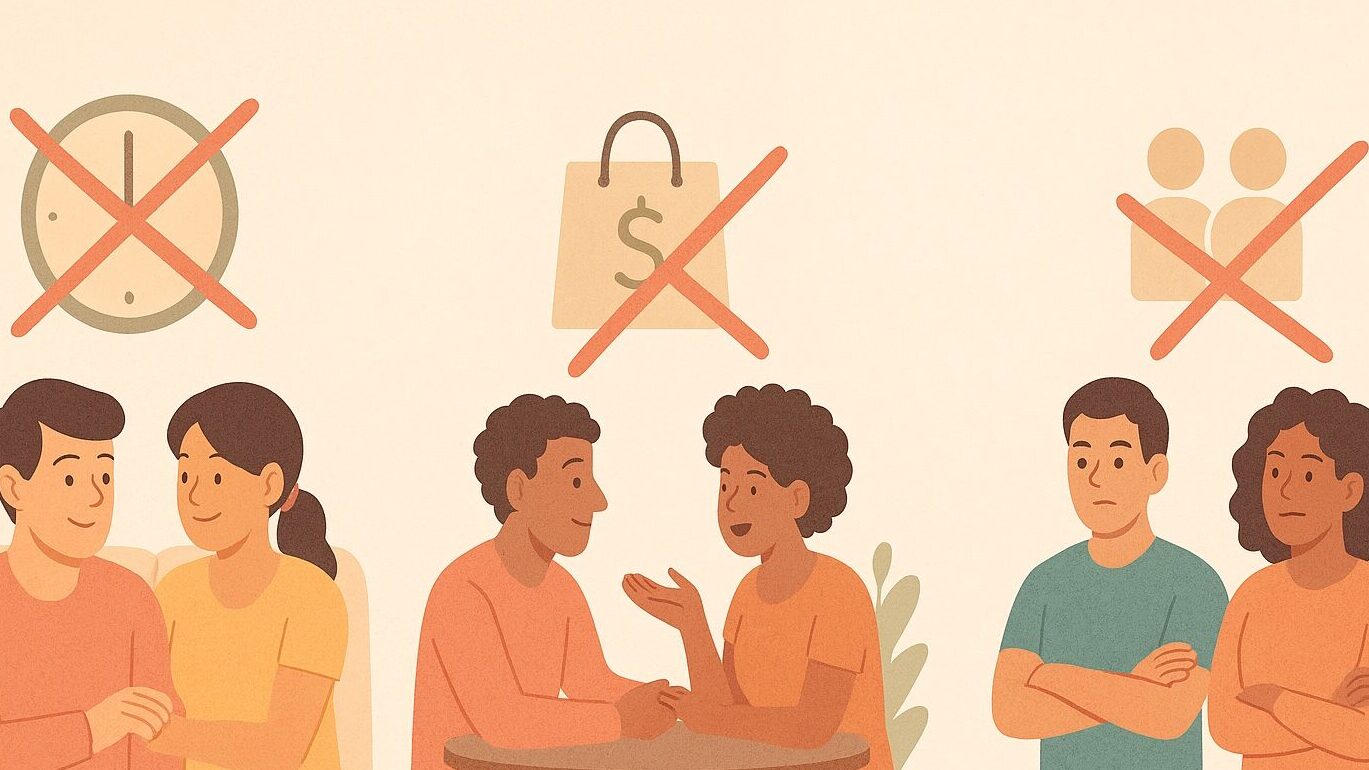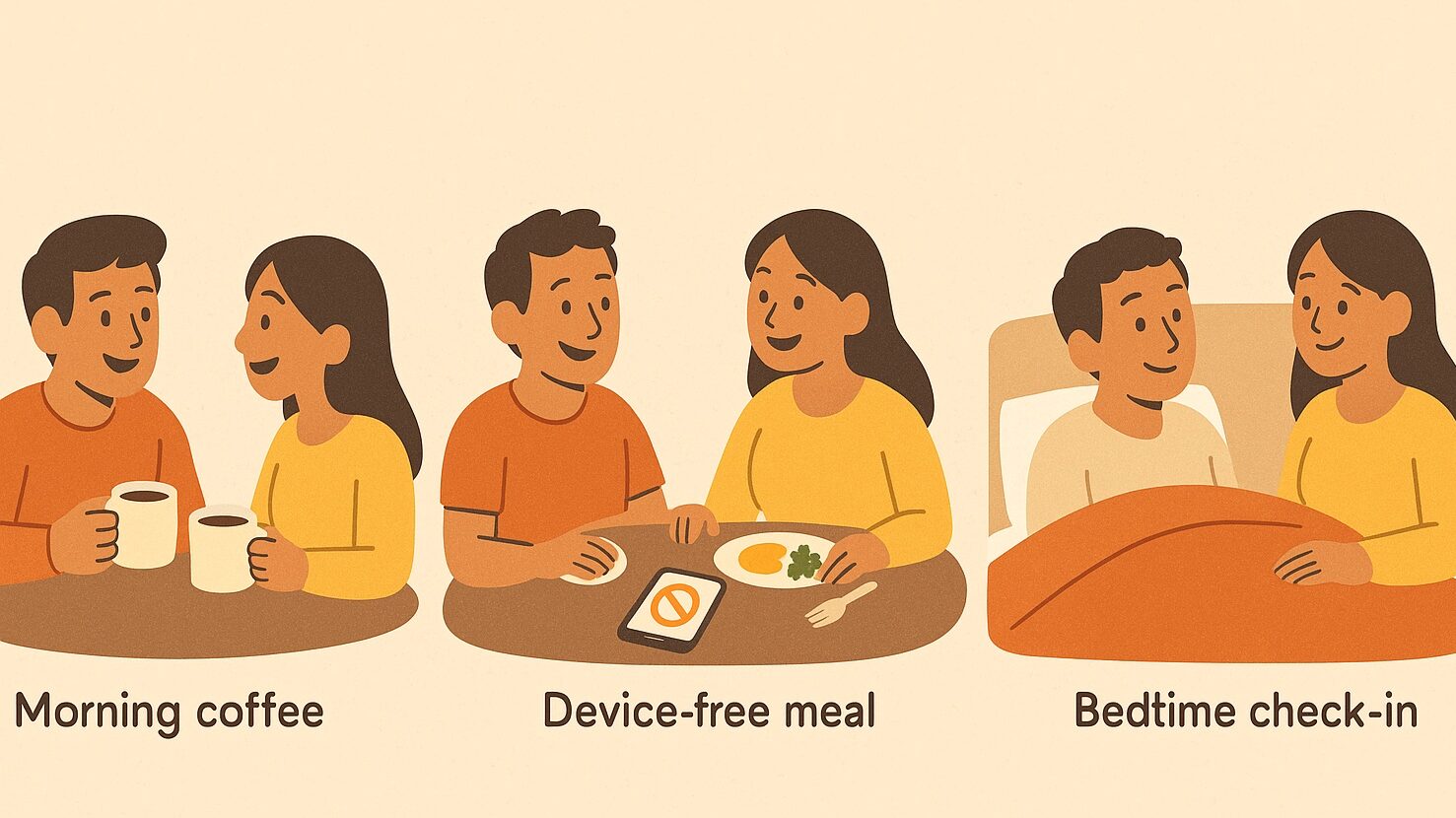Quality Time: The Complete Love Language Guide to Meaningful Connection and Undivided Attention

Quality Time: The Complete Love Language Guide (2025)
“We’re always together, but I feel like we never really connect anymore.”
David and his wife Sarah spend most evenings in the same room—he’s on his laptop handling work emails while she scrolls through social media on her phone. They eat dinner while watching TV, take walks while listening to podcasts, and even their weekend activities involve parallel play rather than genuine interaction. They’re physically present but emotionally absent, together but not truly connected.
For Sarah, whose primary love language is Quality Time, this constant partial attention feels like emotional starvation. She doesn’t need expensive dates or elaborate activities—she craves the simple but increasingly rare experience of having someone’s complete, undivided attention.
If you’ve ever felt lonely despite being surrounded by people, or if you struggle to understand why someone needs “face time” when you’re already spending time in the same space, this comprehensive guide will help you navigate the profound but often misunderstood world of connecting through presence.
Understanding Quality Time: Presence Over Proximity

Quality Time as a love language is fundamentally about attention rather than time spent in the same location. It’s the difference between being together and being present together—between proximity and genuine connection.
Research in relationship psychology shows that Quality Time creates lasting relationship satisfaction because it involves the most precious resource we can offer another person: our complete, undivided attention. In our hyperconnected, multitasking world, giving someone your full presence has become both more rare and more meaningful.
Core Elements of Quality Time:
Undivided Attention:
- Putting away devices, distractions, and competing priorities
- Being mentally present, not just physically present
- Focusing completely on the person and the interaction
- Giving someone the gift of your full awareness and engagement
Meaningful Interaction:
- Engaging in conversations that go beyond logistics and surface topics
- Participating in activities that allow for connection and communication
- Creating space for emotional intimacy and sharing
- Building memories through shared experiences and focused attention
Intentional Presence:
- Choosing to prioritize connection over productivity or entertainment
- Making deliberate decisions to create opportunities for quality interaction
- Setting boundaries that protect time for meaningful connection
- Demonstrating through your choices that the person matters more than other demands
Active Engagement:
- Listening with genuine interest and curiosity
- Asking questions that show you care about their thoughts and experiences
- Responding thoughtfully rather than waiting for your turn to talk
- Being emotionally available and responsive during interactions
The Psychology Behind Why Presence Matters

For people whose primary love language is Quality Time, focused attention creates unique psychological benefits that other expressions of love cannot fully provide.
Attention as a Fundamental Human Need:
Quality attention satisfies deep psychological needs for:
- Recognition: Being seen and acknowledged as important
- Validation: Having thoughts and feelings heard and respected
- Connection: Experiencing genuine emotional intimacy with another person
- Security: Knowing that you matter enough for someone to prioritize you
The Neuroscience of Focused Attention:
When someone gives us their complete attention, it activates neural pathways associated with safety, bonding, and emotional regulation. For people with Quality Time as their love language, these neurological responses are particularly strong and necessary for emotional well-being.
Impact of Divided Attention:
Research shows that partial attention—being physically present but mentally elsewhere—can actually feel worse than absence to people who value Quality Time. The awareness that someone is choosing other priorities while you’re together can create feelings of rejection and unimportance.
Common Misconceptions About Quality Time

Quality Time is often misunderstood, leading to missed opportunities for connection and frustrated expectations on both sides.
Misconception 1: “Quality Time means spending all your time together”
Reality: Quality Time is about the depth of attention during interactions, not the quantity of hours spent together. A 20-minute conversation with complete focus can be more meaningful than an entire evening of parallel activities.
Impact of misconception: People either become overwhelmed by demands for constant togetherness or dismiss the need for focused attention because they’re already spending time in the same space.
Misconception 2: “Quality Time requires expensive activities or special occasions”
Reality: The most meaningful Quality Time often happens during simple, everyday interactions—conversations over coffee, walks without phones, or shared meals with genuine attention to each other.
Impact of misconception: People miss opportunities for daily connection while waiting for special occasions, or they focus on elaborate activities rather than present attention.
Misconception 3: “People who need Quality Time are needy or clingy”
Reality: Needing focused attention for emotional connection is a normal human trait. People with this love language often give Quality Time generously to others and simply need it reciprocated.
Impact of misconception: Legitimate needs for attention and connection are dismissed as character flaws, leading to emotional distance and relationship dissatisfaction.
Misconception 4: “Quality Time means talking constantly”
Reality: Quality Time can include comfortable silence, shared activities, or parallel engagement where both people are fully present. It’s about the quality of attention, not necessarily verbal interaction.
Impact of misconception: People avoid Quality Time because they think it requires constant conversation, missing opportunities for connection through shared presence and activity.
Recognizing Quality Time as a Love Language

Learning to identify when someone values Quality Time helps you connect with them more effectively while understanding their natural way of showing care.
Signs Someone’s Love Language is Quality Time:
They Prioritize Presence:
- They put away devices and distractions when spending time with people they care about
- They seem disappointed when others are distracted during conversations or activities
- They create opportunities for one-on-one time and focused interaction
- They remember and reference conversations and shared experiences in detail
They Crave Undivided Attention:
- They seem frustrated when others multitask during conversations
- They ask questions like “Are you listening?” or “Can we talk without the TV on?”
- They appear more engaged and happy during focused, uninterrupted interactions
- They may feel hurt when others choose entertainment or work over conversation
They Show Love Through Attention:
- They give others their complete focus during conversations and activities
- They plan activities that allow for connection and interaction
- They ask thoughtful questions and show genuine interest in others’ experiences
- They create rituals and traditions that involve dedicated time together
They Feel Disconnected Without Quality Interaction:
- They may express feeling lonely even when surrounded by people
- They seem to need regular opportunities for meaningful conversation or shared activities
- They may withdraw or become distant when Quality Time needs aren’t met
- They express appreciation when others give them focused attention
What Quality Time Looks Like in Practice:
Daily Interactions:
- Having breakfast together without phones or TV
- Taking evening walks focused on conversation rather than exercise or entertainment
- Asking about each other’s day and really listening to the answers
- Spending a few minutes before bed sharing thoughts or feelings
Meaningful Conversations:
- Discussing hopes, dreams, concerns, and experiences beyond daily logistics
- Asking follow-up questions that show genuine interest and curiosity
- Sharing personal thoughts and feelings during focused interaction
- Having regular check-ins about the relationship and individual well-being
Shared Activities:
- Cooking meals together with focus on conversation and connection
- Playing games that encourage interaction and engagement
- Working on projects together that allow for communication
- Attending events or activities that create shared experiences and memories
Effective Quality Time: What Works and What Doesn’t

Not all time spent together creates the emotional connection that people with this love language need. Understanding the difference between effective and ineffective Quality Time is crucial.
What Works: Focused, Intentional Connection
Undivided Attention: Instead of: Talking while checking your phone or watching TV Try: Having conversations with all devices put away and your complete focus on the interaction
Active Engagement: Instead of: Being physically present but mentally elsewhere Try: Asking questions, making eye contact, and responding thoughtfully to what’s being shared
Meaningful Activities: Instead of: Always choosing entertainment that prevents conversation Try: Activities that naturally encourage interaction—cooking together, taking walks, playing conversation-based games
Regular Rituals: Instead of: Hoping Quality Time happens spontaneously Try: Creating regular opportunities for connection—weekly date nights, daily check-ins, or monthly adventure days
What Doesn’t Work: Distracted or Obligatory Time
Avoid Multitasking:
- Checking phones, watching TV, or handling other tasks during conversations
- Half-listening while planning your response or thinking about other things
- Being physically present but emotionally unavailable or distracted
Avoid Rushed Interactions:
- Having important conversations while rushing to other activities
- Making Quality Time feel like an obligation or item to check off a list
- Constantly watching the clock or expressing impatience during focused time
Avoid Competitive Activities:
- Always choosing activities that create winners and losers rather than connection
- Focusing on performance or achievement rather than shared experience
- Using Quality Time as an opportunity to prove points or win arguments
Avoid Superficial Engagement:
- Limiting conversations to logistics, schedules, and surface-level topics
- Going through the motions of spending time together without genuine interest
- Treating Quality Time as less important than other activities or priorities
Quality Time in Different Relationships
Quality Time appears differently across various relationship contexts, but the core principle—giving focused attention and creating meaningful connection—remains consistent.
In Romantic Relationships:
Daily Connection:
- Morning coffee or tea together without devices
- Regular walks or drives focused on conversation
- Cooking and eating meals together with attention on each other
- Bedtime conversations sharing the day’s experiences and feelings
Deeper Intimacy:
- Weekly or monthly deeper check-ins about the relationship and individual goals
- Sharing dreams, fears, and personal growth experiences
- Creating traditions and rituals that involve focused time together
- Planning dates and activities that encourage conversation and connection
Conflict Resolution:
- Setting aside dedicated time to address concerns and disagreements
- Having difficult conversations without distractions or time pressure
- Listening to understand rather than to respond or defend
- Creating safe space for emotional vulnerability and honest communication
In Parent-Child Relationships:
For Young Children:
- Reading together with full attention and interaction
- Playing games that involve conversation and imagination
- Having regular one-on-one time with each child individually
- Creating bedtime rituals that involve talking about the day and feelings
For Adolescents:
- Driving time focused on conversation rather than music or silence
- Shared activities based on their interests that allow for natural conversation
- Regular individual time that doesn’t involve lectures or problem-solving
- Being available for spontaneous conversations when they’re ready to talk
For Adult Children:
- Regular phone calls or visits focused on connection rather than logistics
- Shared experiences and activities that create ongoing memories
- Deep conversations about life, relationships, and personal growth
- Being present during important moments and life transitions
In Friendships:
Meaningful Connection:
- Regular coffee dates or meals focused on catching up and connecting
- Activities that encourage conversation—hiking, crafting, or shared hobbies
- Being fully present during important conversations and life events
- Creating traditions and shared experiences that deepen the friendship
Supportive Presence:
- Offering focused attention during difficult times without trying to fix or solve
- Listening without judgment and showing genuine interest in their experiences
- Making time for friends even during busy periods
- Being emotionally available and responsive during conversations
In Professional Settings:
Team Connection:
- Regular one-on-one meetings that go beyond task management
- Team building activities that encourage genuine interaction and connection
- Creating space for informal conversation and relationship building
- Giving colleagues complete attention during discussions and meetings
Leadership Through Presence:
- Practicing active listening during staff meetings and individual conversations
- Creating opportunities for team members to share ideas and concerns
- Being fully present during performance reviews and difficult conversations
- Showing genuine interest in team members’ professional growth and personal well-being
Daily Practice: Making Quality Time Natural

Building habits of focused attention and meaningful connection requires intentional practice and systems that support regular Quality Time.
Creating Quality Time Awareness:
Notice Attention Patterns: Pay attention to when you’re truly present with others versus when you’re physically there but mentally elsewhere. Awareness is the first step toward change.
Identify Natural Opportunities: Look for existing moments that could become Quality Time with small adjustments—meals, commutes, bedtime routines, or weekend activities.
Observe Response Patterns: Notice which people in your life seem to light up when given focused attention and which activities naturally encourage connection and conversation.
Establishing Quality Time Habits:
Morning Connection: Start each day with focused attention on someone important—sharing coffee with your partner, having breakfast conversation with children, or calling a friend during your commute.
Transition Rituals: Create connection points during daily transitions—focused conversation when returning from work, bedtime check-ins, or weekend morning discussions about the day ahead.
Weekly Traditions: Establish regular opportunities for extended Quality Time—weekly date nights, family game nights, or monthly adventures with friends.
Technology Boundaries for Quality Time:
Device-Free Zones: Designate specific times and places where devices are put away—during meals, in bedrooms, or during the first hour after coming home.
Focused Conversation Practices: Practice having conversations with complete attention—making eye contact, asking follow-up questions, and avoiding the urge to multitask.
Presence Over Productivity: Learn to choose connection over efficiency during designated Quality Time periods, resisting the urge to handle tasks or check notifications.
Overcoming Common Quality Time Challenges

Many people want to give Quality Time but encounter obstacles that prevent effective expression of this love language.
Challenge 1: “I don’t have time for extended conversations or activities”
Solution:
- Focus on quality of attention rather than quantity of time
- Look for small moments throughout the day that can become opportunities for connection
- Start with 10-15 minute focused interactions and gradually increase
- Recognize that meaningful connection doesn’t always require hours of time
Challenge 2: “I get distracted easily during conversations”
Solution:
- Practice active listening skills gradually—start with shorter conversations
- Put away devices and remove other distractions from the environment
- Use techniques like summarizing what you heard to stay engaged
- Be patient with yourself as you develop the skill of sustained attention
Challenge 3: “I don’t know what to talk about during Quality Time”
Solution:
- Prepare conversation starters or questions about their day, thoughts, or experiences
- Focus on listening and asking follow-up questions rather than having perfect topics
- Share your own experiences and feelings to model the type of interaction you want
- Remember that comfortable silence can also be Quality Time
Challenge 4: “Quality Time feels forced or artificial”
Solution:
- Start with activities you naturally enjoy that also allow for connection
- Focus on genuine interest in the other person rather than perfect execution
- Allow natural conversation and interaction rather than forcing deep discussions
- Understand that developing Quality Time skills takes practice and patience
Quality Time in the Digital Age

Modern technology creates unique challenges for Quality Time, but also opportunities for creative connection when used thoughtfully.
Digital Distractions and Quality Time:
The Attention Economy: Our devices are designed to capture and hold attention, making focused presence increasingly difficult but more valuable than ever.
Partial Attention Syndrome: Constantly available technology creates habits of divided attention that can make Quality Time feel unnatural or challenging.
FOMO and Productivity Pressure: Fear of missing out on digital information or pressure to be constantly productive can interfere with the ability to be fully present.
Strategies for Quality Time in a Connected World:
Intentional Technology Use:
- Create specific times and spaces where devices are not allowed
- Use technology to enhance connection (video calls with distant family) rather than replace in-person attention
- Practice putting devices away during conversations and meals
- Set boundaries around work communication during personal time
Digital Detox Practices:
- Regular periods of disconnection from devices to focus on relationships
- Technology-free activities that naturally encourage conversation and connection
- Mindful use of entertainment and social media to avoid automatic scrolling
- Creating phone-free zones in homes and during activities
Virtual Quality Time:
- Video calls that involve focused conversation rather than multitasking
- Online activities that encourage interaction and connection with distant friends and family
- Using technology to maintain meaningful relationships across distance
- Digital traditions that create ongoing connection (weekly video dates, online game nights)
When Quality Time Becomes Problematic

Like any love language, Quality Time can become unhealthy when taken to extremes or used inappropriately.
Red Flags to Watch For:
Demanding Constant Attention:
- Expecting someone to be available for focused interaction at all times
- Becoming upset when others need time for individual activities or responsibilities
- Using guilt or manipulation to secure attention and time
- Not respecting others’ need for solitude or independent activities
Controlling Through Time Demands:
- Using Quality Time requirements to limit someone’s other relationships or activities
- Making unreasonable demands for attention that interfere with work, friendships, or personal growth
- Using the withdrawal of Quality Time as punishment during conflicts
- Creating isolation by demanding all of someone’s available attention
Rejecting Other Love Languages:
- Dismissing other expressions of love because they don’t involve focused attention
- Refusing to appreciate acts of service, gifts, or physical affection when Quality Time needs aren’t met
- Making Quality Time the only acceptable way to show or receive love
- Creating unrealistic expectations that all interactions must be deeply meaningful
Healthy Boundaries with Quality Time:
Balanced Expectations:
- Recognizing that meaningful connection enhances but doesn’t replace individual growth and activities
- Understanding that not all time together needs to be intensely focused or deeply meaningful
- Appreciating Quality Time while also valuing other expressions of love and care
- Respecting others’ different communication styles and attention capacities
Mutual Respect:
- Asking for Quality Time rather than demanding it
- Understanding when others genuinely need to focus on other priorities
- Giving Quality Time freely rather than keeping score or creating obligations
- Recognizing that healthy relationships include both connection and independence
Cultural and Generational Considerations

Different cultures and generations have varying approaches to Quality Time, which affects how it’s expressed, received, and valued.
Cultural Variations:
Collectivist vs. Individualist Cultures:
- Some cultures naturally emphasize group time and family connection
- Others prioritize individual achievement and may have less structured family time
- Understanding cultural context helps determine appropriate Quality Time expressions
Communication Styles:
- High-context cultures may emphasize presence and shared experience over verbal interaction
- Low-context cultures might focus more on explicit conversation and direct communication
- Both styles can express Quality Time effectively when cultural preferences are respected
Generational Differences:
Technology Integration:
- Different generations have varying comfort levels with technology during interpersonal interactions
- Younger generations may be more comfortable with virtual Quality Time
- Older generations might prefer traditional face-to-face interaction without devices
Attention Spans and Multitasking:
- Generational differences in attention span and multitasking comfort
- Varying expectations about depth and duration of focused interactions
- Different definitions of what constitutes meaningful connection
Bridging Cultural and Generational Differences:
- Communicate openly about Quality Time preferences and expectations
- Find ways to honor different cultural and generational approaches to connection
- Create opportunities for Quality Time that work for all involved parties
- Focus on the shared desire for connection rather than specific methods
Building Quality Time Skills Progressively

If Quality Time doesn’t come naturally to you but you want to connect better with someone who values it, developing these skills gradually will feel more authentic and sustainable.
Progressive Skill Development:
Week 1-2: Attention Awareness
- Notice your current patterns of attention and distraction during interactions
- Practice recognizing when others are giving you Quality Time
- Observe which types of activities naturally encourage connection and conversation
- Begin putting devices away during some conversations and meals
Week 3-4: Basic Presence Skills
- Practice giving complete attention during short conversations (5-10 minutes)
- Ask follow-up questions to show interest and engagement
- Work on making eye contact and using body language that shows attention
- Start one regular Quality Time activity (daily coffee, weekly walk, etc.)
Week 5-8: Expanding Connection
- Increase the duration of focused interactions gradually
- Practice active listening skills—summarizing, asking clarifying questions
- Create regular opportunities for Quality Time in your schedule
- Experiment with different activities that encourage meaningful interaction
Week 9-12: Advanced Quality Time Skills
- Develop comfort with deeper conversations and emotional sharing
- Learn to balance talking and listening during Quality Time interactions
- Create meaningful traditions and rituals that involve focused connection
- Practice being fully present even during difficult or challenging conversations
Overcoming Development Barriers:
“I get bored during long conversations”: Start with shorter interactions and gradually build your attention span. Focus on asking questions and showing genuine curiosity about the other person.
“I feel like I should be doing something productive”: Reframe Quality Time as an investment in relationship health and recognize that connection is productive for long-term well-being.
“I don’t know how to have deep conversations”: Start with simple questions about daily experiences and feelings, then gradually move toward more meaningful topics as comfort increases.
“I feel anxious about giving someone my complete attention”: Practice with low-stakes relationships and gradually build comfort with sustained focus and presence.
The Long-Term Impact of Consistent Quality Time

When practiced consistently and appropriately over time, Quality Time creates profound positive changes in relationships and individual well-being.
Relationship Benefits:
Deeper Emotional Intimacy: Regular focused attention creates opportunities for emotional sharing and vulnerability that strengthen relationship bonds.
Better Communication: Consistent Quality Time improves listening skills and creates habits of meaningful interaction that enhance all aspects of relationship communication.
Increased Understanding: Focused attention over time leads to deeper knowledge of each other’s thoughts, feelings, dreams, and concerns.
Enhanced Conflict Resolution: Skills developed through Quality Time—listening, presence, attention—directly improve the ability to navigate disagreements and challenges effectively.
Individual Benefits:
Improved Attention Skills: Regular practice of focused presence enhances overall attention span and reduces susceptibility to distraction.
Enhanced Emotional Intelligence: Quality Time interactions develop skills in reading emotions, responding appropriately, and understanding interpersonal dynamics.
Reduced Loneliness: Meaningful connection through Quality Time significantly reduces feelings of isolation and emotional disconnection.
Greater Life Satisfaction: People who regularly engage in Quality Time report higher levels of happiness and satisfaction with their relationships and overall life.
Family and Community Benefits:
Stronger Family Bonds: Families that prioritize Quality Time develop stronger connections, better communication, and more resilience during challenges.
Improved Social Skills: Children who experience consistent Quality Time develop better interpersonal skills and emotional regulation abilities.
Enhanced Community Connection: Communities where Quality Time is valued develop stronger social bonds and better support systems for all members.
Conclusion: The Gift of Presence
In our hyperconnected but often disconnected world, Quality Time represents one of the most precious gifts we can offer another person: our complete, undivided attention. When we choose to be fully present with someone, we communicate that they matter more than our devices, our tasks, our distractions, and our other priorities.
For people whose primary love language is Quality Time, focused attention isn’t just nice to receive—it’s essential for feeling loved, valued, and emotionally connected. When we learn to give the gift of presence and create opportunities for meaningful interaction, we build relationships characterized by deep understanding, emotional intimacy, and genuine connection.
Whether you naturally connect through Quality Time or are learning to give focused attention to someone who values it, remember that Quality Time is about choosing connection over distraction and people over productivity. The investment you make in developing presence skills and consistently offering focused attention will return to you in stronger relationships, deeper understanding, and the profound satisfaction of truly knowing and being known by the people who matter most.
Understanding Quality Time as part of the complete love languages framework helps create relationships where everyone feels seen, heard, and valued. When we become fluent in the language of presence, we contribute to building a world where genuine human connection can thrive despite the pull of digital distraction and busy schedules.
Ready to Discover Your Love Language Profile?
Understanding whether Quality Time is your primary love language—or learning how to effectively give focused attention to others—begins with taking our comprehensive assessment. Discover your unique love language profile and get personalized guidance for building stronger, more connected relationships through all five love languages.
Take the Love Language Quiz Now
Want to explore specific challenges with giving or receiving Quality Time? Learn about managing digital distractions during connection time, or discover strategies for creating meaningful interaction even with busy schedules and competing priorities.


Leave a Reply